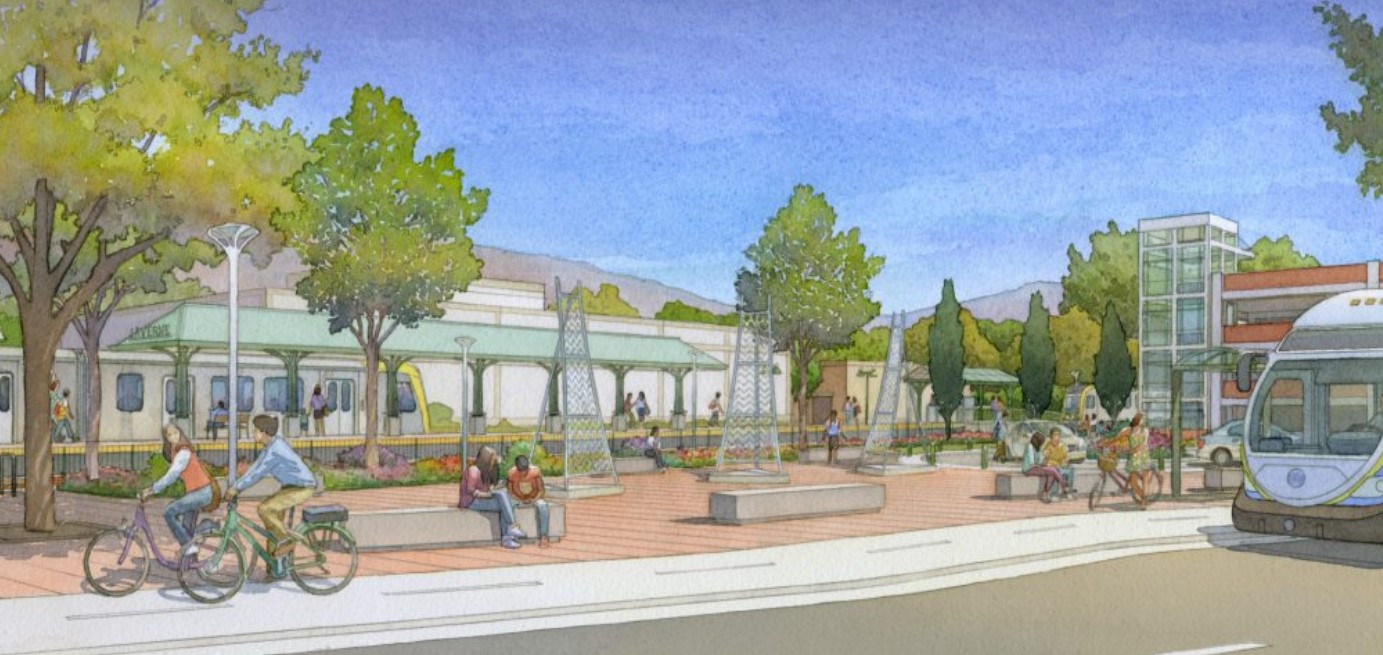Last night, the Foothill Gold Line Construction Authority held a public hearing on its revised environmental studies. Though the full Foothill Gold Line extension from Glendora to Montclair was environmentally cleared in 2013, additional studies were needed to build the project in shorter phases than were anticipated. While the new environmental studies keep the project largely the same as it has been, they propose adding a controversial road-widening project in Old Town La Verne.
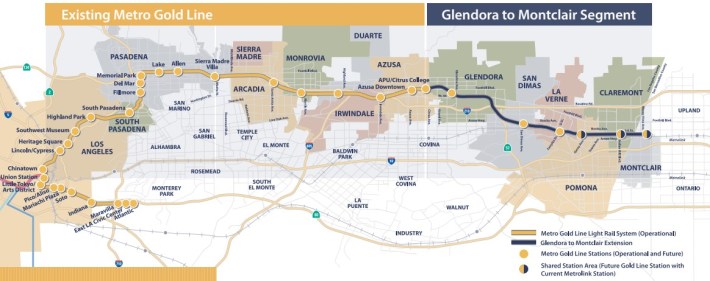
The Foothill Gold Line extension 2B will extend 12.5 miles east from the current Azusa terminus, through the cities of Glendora, San Dimas, La Verne, Pomona, Claremont, and Montclair. The project includes six new stations - one in each of these cities. Though much of the extension will run on an existing unused rail right-of-way, the project gets complicated from Pomona eastward where the right of way is shared with active rail traffic. Adding to the complexity, the Montclair terminus is located in San Bernardino County, just outside L.A. County. The project is being built by the Foothill Gold Line Extension Construction Authority and will be operated by Metro.
The estimated full design/build contract had been anticipated to cost $1.5 billion - the amount of funding Metro and the Authority had lined up for the project. In 2018, actual bids came in at $2.1 billion.
The Authority quickly worked to adjust plans, initially looking to green light only the first eight miles of the project. That would include three new stations, and would end in the city of La Verne. In January, the Metro board weighed in in favor of a nine-mile four-station initial phase that would end in the city of Pomona - at the Pomona-North Metrolink station. There is already enough funding for an extension to La Verne, but some additional funding (estimated at $230 million, though this may change based on revised bids) may be needed to initially get to Pomona.
The new supplemental environmental impact report (SEIR) proposes splitting the extension into four phases, which could proceed separately or in combination.
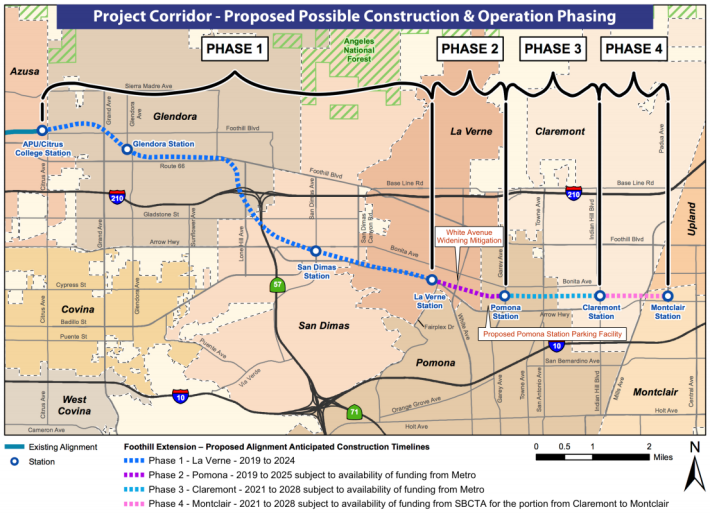
The SEIR proposes a relatively innocuous change to the planned parking structure for the Pomona station. The approved 850-space parking structure had been sited northeast of the station. Due to traffic conflicts with a trucking company adjacent to that site, the SEIR now proposes an alternative site south of the station.
The proposed SEIR change that was most controversial at last night's meeting was a proposed widening of La Verne's White Avenue. With the temporary project terminus further west, more drivers are expected to use the parking at stations that will ultimately be in the middle of the extension. With that car traffic and passing trains briefly blocking perpendicular streets, the SEIR concluded that several intersections would experience delays to drivers. This impact is based on the outdated and discredited Level of Service metric that always prescribes more car-centric design.
Based on the intersection impacts, the Authority is proposing to widen White Avenue from Arrow Highway to 6th Street in the heart of the city of La Verne. Today, White Avenue is one lane in each direction, with a median turn lane. This portion of White, in Historical Old Town La Verne, is lined with mature trees and single-story homes, many historic. The proposal would remove parkways to widen White to two traffic lanes in each direction, with turn lanes at intersections.
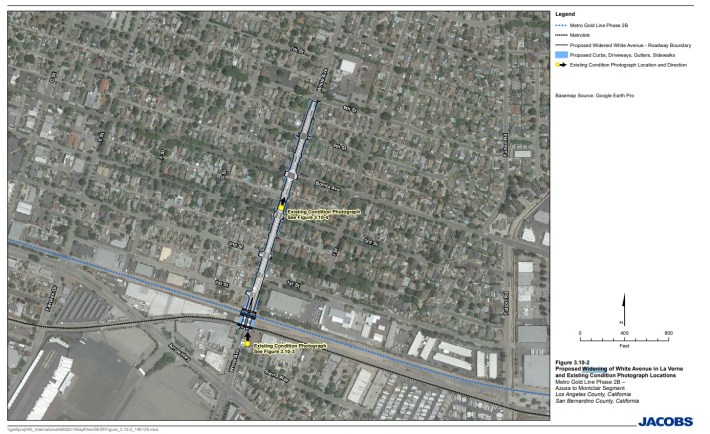
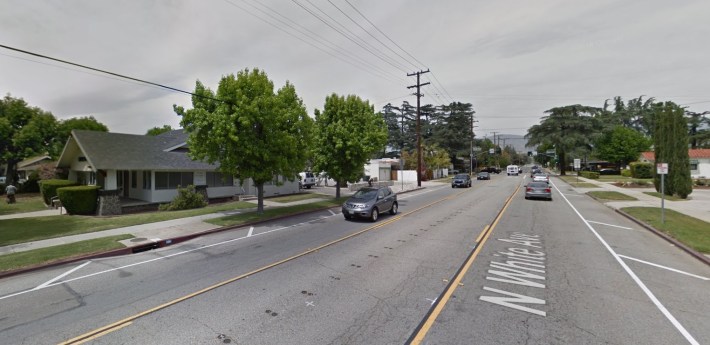
Last night's meeting took place at the La Verne Community Center, not far from Old Town. Among the approximately 120 people in attendance, the proposed White Avenue widening was a lightning rod for criticism. About 20 speakers made public comments. More than a dozen commenters spoke against widening White Avenue. No speakers raised any criticism of the actual transit aspects of the Gold Line project.
Several residents spoke of White Avenue's history of "accident after accident" with car crashes "taking out trees [and] telephone lines" and "coming through hedges and gardens" and, in at least one case, crashing into a home. Speakers voiced opposition to widening anticipating that more lanes would mean more traffic and more crashes. Several speakers decried the noise impacts from a 4-lane street, which they compared to "living on a freeway." Many criticized the widening as adversely impacting the safety, walkability, and bikeability of their beautiful peaceful historic neighborhood. Some asserted that the widening was a "done deal" foisted on the community by an unresponsive La Verne City Hall. Several speakers requested that the widening be abandoned, or at least postponed.
It is sad is that, in 2019, transit agencies are still proposing these crappy community-damaging "mitigations" for traffic impacts. At a time when the state of California is abandoning LOS due to its pernicious effect on environmental analysis, this SEIR widening is exceedingly backwards-looking. Two decades into the 21st Century, with climate disruption threatening, it is ridiculous for transit agencies to be stuck in destructive 20th Century ruts like road widening. It is reminiscent of the sad satirical Strong Towns conversation with a traffic engineer.
The SEIR is inconsistent in its response to traffic impacts. The SEIR (according to an Authority fact sheet) acknowledges the Glendora Avenue/Route 66 intersection will experience traffic impacts, but recommends "no identified mitigation measures without substantial right-of-way acquisitions and secondary impacts" and declares "a new unmitigable significant impact at this intersection." Perhaps the SEIR could acknowledge the supposed White Avenue traffic impacts, but conclude they are unmitigable without adversely impacting the neighborhood.
Alternately, the SEIR prepared by a transit agency should probably focus on mitigation that would enhance transit. Instead of spending tens of millions of dollars to increase La Verne car traffic, why not instead invest in transportation demand management (TDM) solutions? These might include programs to provide free (and/or discounted) transit passes for area students, seniors, residents, and/or employers. Funding could go to implementing and/or expanding transit service - which could be bus, shuttle, MicroTransit, mobility on demand, and/or even shared ride-hail. Another possibility is investing in making first/last mile active transportation connections safer and easier, by calming traffic, adding bicycling facilities and/or bike-share.
Hopefully the Gold Line Authority will listen to its constituents and will figure out an appropriate way to drop the expensive and vehemently opposed White Avenue widening from its plans. Hopefully opposition to widening does not bubble over into legal challenges that could delay moving forward with the rail project as quickly as possible.
The full Gold Line Supplemental Environmental Impact Report is available at the Authority's website. The 45-day public comment period will end on May 6. Comments can be submitted via email to LLevyBuch[at]foothillgoldline.org
The Construction Authority anticipates that its board will approve the SEIR this June or July. The board would soon thereafter approve the design/build contract. Construction would likely get underway in 2020, with an initial Pomona extension anticipated to open to the public around 2025. If additional funding is secured, the agency anticipates the full Montclair extension could be completed by 2028.
SBLA San Gabriel Valley coverage is supported by Foothill Transit, offering car-free travel throughout the San Gabriel Valley with connections to the new Gold Line Stations across the Foothills and Commuter Express lines traveling into the heart of downtown L.A. To plan your trip, visit Foothill Transit. “Foothill Transit. Going Good Places.”
